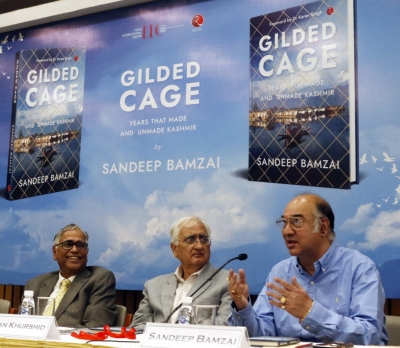New Delhi: A number of popular misconceptions about the Kashmir policy of Jawaharlal Nehru were corrected on Thursday evening by the distinguished panellists who gathered at the India International Centre here to release IANS Editor-in-Chief, MD and CEO Sandeep Bamzai’s book, “Gilded Cage: Years That Made and Unmade Kashmir”.
Former J&K Finance Minister, banker and columnist Haseeb Drabu pointed out that by going to the United Nations under Article 35, Chapter 7 of the world body’s constitution, and not Article 39, Chapter 7, Nehru insulated Jammu & Kashmir from any active UN intervention, and limited its role to passing non-binding resolution.
It is this position that enabled India, as Bamzai noted, refuse to accept the UN plebscite administrator for Jammu and Kashmir, the US World War II naval hero, Admiral Chester Nimitz, whose views on the matter was inimical to India’s interests. Pakistan, of course, wholeheartedly accepted him and he served in his position from 1949 to 1953.
The discussion that followed the formal unveiling of the book published by Rupa was chaired by the IIC Director, K.N. Shrivastava.
Another important point made by Lt General Syed Ata Hasnain, who retired as GOC, of Srinagar-headquartered 15 Corps, was that the Indian Army, hamstrung by absolutely no logistical support, pulled off a miracle in its war to defend Jammu and Kashmir at a time when the border did not even have proper roads and the Jawahar Tunnel under the Pir Panjal was still years away.
Gen. Hasnain said that at a time when the old Dakotas could barely move people, the Army had to dismantle tanks, transport them in parts on trucks, and then re-assemble them.
These tanks, according to senior Congressman and lawyer Salman Khurshid, played a critical role in the battles that ultimately saved Jammu and Kashmir for India.
Gen. Hasnain began his talk by remembering that he led the 19th Infantry Division at Baramulla, where Brigardier Rajinder Singh Jamwal of the Jammu and Kashmir State Forces, died a martyr’s death fighting the first wave of tribal raiders from Pakistan.
He also amplified a point made by Khurshid — that the leadership of the Army of newly independent India, especially General K.M. Cariappa, the then Chief, and General K.S. Thimayya, who was leading the 19th Infantry Division, was divided on the extent to which to engage Pakistan militarily.
Gen. Hasnain, who praised the book for its deep understanding of military operations, said the Indian Army was fighting against logistical odds. “The soldiers were on slow-clad peaks wearing PT shoes,” he said.
The Army, Gen. Hasnain recalled, had captured a peak in the Pir Panjal ranges called Pir Kathi, but it could not hold on to it because the soldiers had no snow clothing. As a result, Indian soldiers had to withdraw from the strategically imporant Haji Pir Pass, which was recaptured by the Indian Army in 1965. Of course, it had to be returned to Pakistan Occupied Kashmir (POK) under the terms of the Tashkent Agreement.
The Army was not prepared, he noted, for fighting at the height of winter and so it was a realistic move not to advance beyond what we now know as the Line of Control (LOC), as was being suggested by Nehru’s private secretary, and eyes and ears on Kashmir, D.N. Kachru.
Drabu made two additional points of note:
(a) Article 370 was inserted into the Constitution to safeguard the revolutionary land reforms introduced by Sheikh Mohammad Abdullah in Jammu and Kashmir in 1948, which, besides his move to make education free for girls, was responsible for the former state’s social and economic indicators to be higher than the national average even before the present dispensation taking over Jammu and Kashmir and Ladakh.
(b) The existing LOC is a realistic construct because it separates the Kashmiri-speaking part of the state from the non-Kashmiri-speaking areas that are now in POK.
The consensus that emerged out of the discussion was that if Jammu and Kashmir is still an indivisible part of India, the credit must go to Nehru’s smart handling of a difficult situation and his personal and political equations with Sheikh Abdullah before their falling out in 1953.
–IANS


Comments are closed.